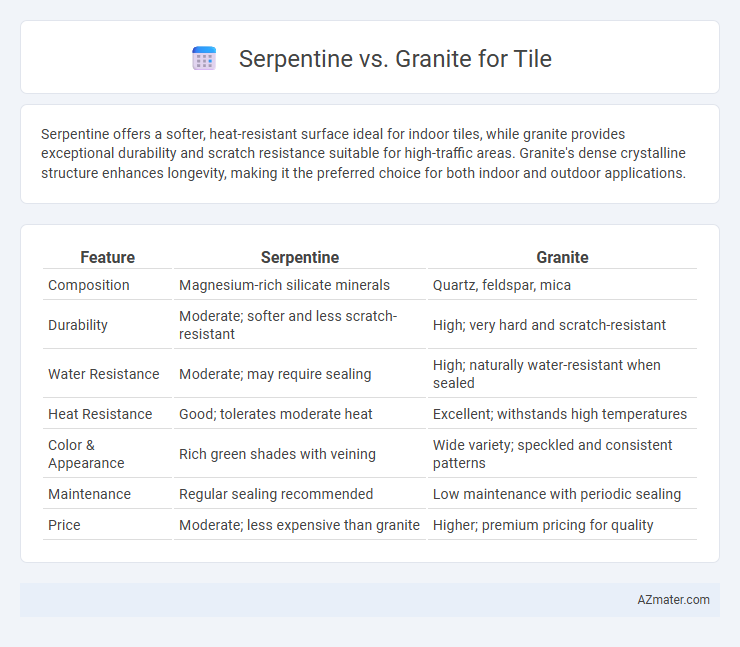Serpentine offers a softer, heat-resistant surface ideal for indoor tiles, while granite provides exceptional durability and scratch resistance suitable for high-traffic areas. Granite's dense crystalline structure enhances longevity, making it the preferred choice for both indoor and outdoor applications.
Table of Comparison
| Feature | Serpentine | Granite |
|---|---|---|
| Composition | Magnesium-rich silicate minerals | Quartz, feldspar, mica |
| Durability | Moderate; softer and less scratch-resistant | High; very hard and scratch-resistant |
| Water Resistance | Moderate; may require sealing | High; naturally water-resistant when sealed |
| Heat Resistance | Good; tolerates moderate heat | Excellent; withstands high temperatures |
| Color & Appearance | Rich green shades with veining | Wide variety; speckled and consistent patterns |
| Maintenance | Regular sealing recommended | Low maintenance with periodic sealing |
| Price | Moderate; less expensive than granite | Higher; premium pricing for quality |
Introduction: Serpentine and Granite as Tile Materials
Serpentine and granite are popular natural stones used for tile flooring and wall applications, valued for their durability and unique aesthetics. Granite, composed mainly of quartz and feldspar, offers superior hardness and resistance to wear, making it ideal for high-traffic areas. Serpentine, characterized by its rich green hues and softer composition, provides a distinctive, elegant look but requires more maintenance due to its relative porosity compared to granite.
Origins and Geological Formation
Serpentine originates from the metamorphic alteration of ultramafic rocks rich in magnesium and iron, forming in subduction zones where oceanic crust is metamorphosed under low temperature and high pressure. Granite forms deep within the Earth's continental crust through the slow crystallization of magma composed mainly of quartz, feldspar, and mica, resulting in its coarse-grained texture. These distinct geological formations contribute to their differing mineral compositions and physical properties, making serpentine softer and more reactive, while granite is harder and more durable for tile applications.
Physical Properties and Appearance
Serpentine tiles display a smooth, often greenish surface with natural veining, while granite tiles offer a granular texture with varied speckled patterns in shades ranging from gray to pink. Granite's higher hardness rating of 6-7 on the Mohs scale ensures superior scratch resistance compared to serpentine's softer rating of 3.5-4, making granite more durable for high-traffic areas.
Durability and Hardness Comparison
Serpentine tiles have a Mohs hardness rating between 3 and 6, making them softer and more prone to scratching and chipping compared to granite, which typically scores 6 to 7. Granite's superior durability and resistance to abrasion make it ideal for high-traffic areas and outdoor applications. The higher density and hardness of granite contribute to its long-lasting performance as a tile material in both residential and commercial settings.
Water and Stain Resistance
Serpentine tiles exhibit moderate water resistance but tend to be more porous and prone to staining compared to granite, requiring regular sealing to maintain durability. Granite is naturally dense and highly water-resistant, making it less susceptible to stains and ideal for high-moisture areas like kitchens and bathrooms. Choosing granite over serpentine offers enhanced longevity and easier maintenance due to its superior resistance to water absorption and staining.
Maintenance and Care Requirements
Serpentine tiles require regular sealing and careful cleaning to prevent etching and staining due to their softer, more porous nature compared to granite. Granite tiles are highly durable and resistant to scratches and stains, demanding less frequent sealing and simpler maintenance with non-abrasive cleaners. Both materials benefit from prompt spill cleanup and routine dusting, but granite's hardness offers superior longevity with minimal upkeep.
Installation Process and Challenges
Serpentine tiles, known for their rich green hues and moderate hardness, require specialized cutting tools during installation to prevent chipping due to their slightly softer and more fibrous structure compared to granite. Granite tiles, with their higher density and durability, demand more robust cutting equipment and careful handling to avoid dust and cracking, often resulting in longer installation times. Both materials present challenges in achieving precise grout lines and ensuring proper substrate preparation, but serpentine's variable mineral composition can lead to uneven surfaces, increasing the complexity of leveling during installation.
Cost and Availability
Serpentine tile generally costs less than granite due to its relative abundance and easier extraction process. Granite is often more expensive because it is harder to quarry and requires more processing, making it a premium choice for tile. Availability of serpentine is widespread in regions with serpentinite formations, whereas granite availability depends on specific geological locations, affecting both price and supply consistency.
Best Applications for Each Stone
Serpentine is ideal for indoor applications such as bathroom floors, countertops, and wall cladding due to its resistance to moisture and unique green veining that adds aesthetic appeal. Granite excels in high-traffic areas like kitchen countertops, outdoor patios, and commercial flooring because of its exceptional durability, hardness, and resistance to scratches and heat. Choosing serpentine enhances elegance in low-impact spaces, while granite provides toughness and longevity for demanding environments.
Conclusion: Choosing Between Serpentine and Granite Tiles
Serpentine tiles offer unique green and dark veining with a softer, more easily carved texture, ideal for decorative or low-traffic areas. Granite tiles provide unparalleled durability, hardness, and resistance to scratches and heat, making them perfect for high-traffic or kitchen environments. Selecting between serpentine and granite ultimately depends on balancing aesthetic preferences with functional needs such as durability and maintenance.

Infographic: Serpentine vs Granite for Tile
 azmater.com
azmater.com